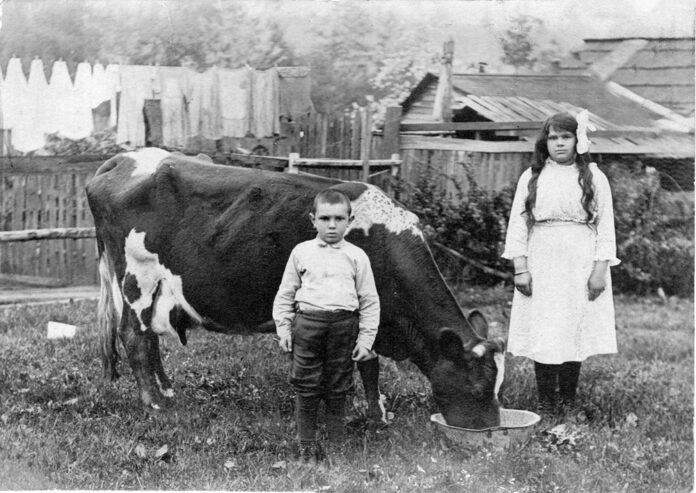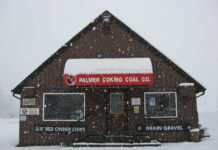This 1918 photo features Louie Draghi, his sister Mary, and Suzy, one of three family cows. It was taken on their parents, Pete and Nealdi Draghi’s 7.6-acre farm in Black Diamond, leased from Pacific Coast Coal Co (Pacific Coast). At the time, Pete worked in Pacific Coast’s coal mines, while his wife, Nealdi (Fontana) and their children undertook labors around the home. Their chores included milking the cows, caring for animals, supplying wood and coal to heat the home, cleaning the home and barns, plus planting and weeding the garden. The Draghi’s 1/4-acre garden provided quality produce consisting of fruits and vegetables, much of which Nealdi canned for the year.
The Draghi family were part of the fabric of Black Diamond. Pete and Nealdi (Fontana) immigrated from the Tuscany region of Italy about 1900. When Prohibition took effect in 1920, Pete and his daughter, Mary ran a basement speakeasy called Big Mary’s Place. A Saturday night raid by federal agents conducted on March 16, 1925 found “a goodly representation of automobiles from Seattle and Tacoma parked along the streets of Black Diamond,” noted the Chief Hazeltine of Prohibition Enforcement.
Four establishments were busted, and 2,000 gallons of contraband alcoholic beverages confiscated. “Black Mary” as the newspapers called her was the “reputed queen of the foothill bootleggers” and arrested with her father and four others, Aniceto Magnani, Nello Merlino, and Carlo and Leo Fontana. Two years later, Mary Draghi, then 22 was fined $250 and given a suspended sentence of sixty days in jail on liquor possession charges. Her mother, Nealdi Draghi was fined $500 and a similar sentence.
Mary’s younger brother, Louie Draghi attended the Black Diamond grade school, but was held back in the first grade, not yet speaking English. Only Italian was spoken at home. Louie worked his early years as a logger in the Olympic forest, but jobs were sporadic, so he returned to Black Diamond and began employment in the coal mines. In 1952, Louie purchased 5.6 acres, located just west of his family’s farm from Pacific Coast. The property was east of Highway 169 on a hillside overlooking Jones Lake.
With a lease from Pacific Coast, Louie opened a small mine on the McKay seam that was a profitable operation due to the high quality of the coal. Contracts were negotiated to supply coal to the Black Diamond school and Enumclaw High School on Porter Street. Louie Draghi had a keen intellect and knew much about underground mining. Despite his knowledge, he experienced several close calls with death, which are inherent in mining with sloping coal seams.
Draghi constructed three different coal bunkers on his property and his business thrived for 12 years until demand for coal lessened. In 1963, Louie closed his operation, but found work with Palmer Coking Coal Company, who had bought out Pacific Coast’s interest and to whom Draghi once paid royalties. All-in-all, Louie accumulated about 40 years in the coal industry including stints with Palmer, Pacific Coast Coal, Northwest Improvement, and T.A. Olson Fuel Company. Louie died in 1976, just shy of his 66th birthday. He is buried in the Black Diamond Cemetery near his sisters, Mary and Ann, and brothers, Joe and Angelo.
This photo comes courtesy of his son, Lou Draghi with coordination provided by JoAnne Matsumura, an Issaquah historian. Photo enhancement was provided by Andy Newell, owner of Mancraft Graphics of Black Diamond.







